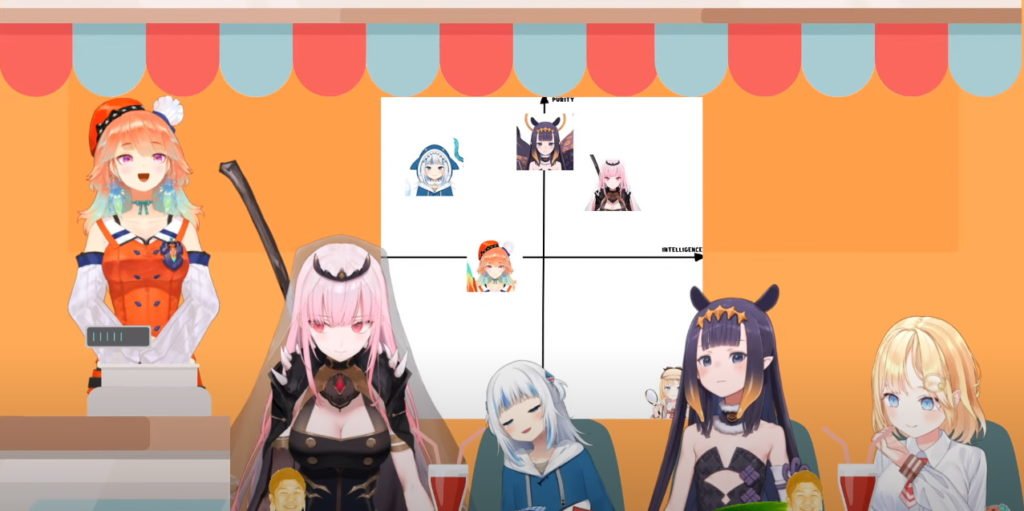The official Rice Digital totally seiso guide to VTuber lingo
“What does ‘seiso’ mean?” If you’re a new VTuber fan, chances are you’ve found yourself asking this or other such questions.
Whenever you involve yourself with a new hobby or interest, there’s always a period of time in which you need to “adjust” to the culture somewhat — even if you have no intention of being part of the broader fandom. A big part of that is learning the specialist terminology that goes along with a particular area of interest — because even if you’re not participating directly in discussions, you’ll doubtless come across certain terms when reading articles, watching videos or engaging with your new hobby directly.
The VTuber subculture is no exception, having spawned plenty of its own specialist lingo over time. And with the whole phenomenon being such an international thing, there’s a bit of a mix of different languages going on, too, which can make things even more confusing.
Never fear, though, dear reader, because Rice Digital is here to help you parse out some of the most common pieces of terminology you’ll encounter when having fun with VTubers. Soon you’ll be able to meme with the best of them! Let’s get started.
2D
A VTuber whose avatar is based on a drawing rather than a polygonal model. Usually combined with Live2D technology to bring the drawing to life with body movements and facial animations. A 2D VTuber is often a collaborative creation between an artist and a rigger, who are typically referred to as the VTubers “mama/papa” and “Live2D mama/papa” respectively.
3D
A VTuber whose avatar is based on a polygonal model. 3D VTubers often have more freedom of movement thanks to the ability to use technology such as VR hand-tracking controllers, but this comes at the expense of detail.
Many VTubers have both 2D and 3D models, with the latter often used for singing and dancing performances — or simply shitposting, as seen above from the dearly departed Kiryu Coco.
Bottom left

A term somewhat related to the concept of “seiso“, “bottom left” refers to a position on a two-axis “alignment chart” depicting an individual’s purity and intelligence. Anything left of centre is below-average intelligence, and anything below the centre is erring on the lewd side of things.
During one of Hololive English’s first collaborative streams, everyone joked about Takanashi Kiara’s position being on the “bottom left” of the chart, implying that she is endearingly dumb and lewd. Huke, character designer of Kiara, also agreed with this assessment, so the definition has stuck — and is promptly trotted out any time Kiara is seen being a little too thirsty, particularly towards Calli.
Notice Amelia Watson’s self-assessed position as being on the bottom right extreme of the chart, denoting that she has both maximum intelligence and the peak of lewdness — though she still berates chat any time they get a bit frisky.
The arrival of Nijisanji EN’s Finana Ryugu, one of the most unashamedly lewd VTubers (though often unintentionally), necessitated a considerable expansion of both the left and lower sides of this chart, particularly once she told her “egg” story and had opinions on what stirring wet noodles sounded like.
Cardboard
If a VTuber encounters difficulty streaming with their animated model — perhaps due to playing a game that is so demanding on their computer that their avatar capture software’s performance suffers — they will sometimes substitute their animated avatar with a flat, non-animated piece of 2D artwork, like a cardboard cutout.
Cardboard avatars are often seen on collaborative streams, where the hosting VTuber is fully animated and the guest VTubers light up or switch to a different pose when speaking.
Debut
A VTuber’s first full stream. Usually formalised in structure, relatively short and featuring no audience interaction. During a debut stream, the VTuber will introduce themselves and their “character”, talk about their likes and dislikes, give credit to their “mamas” and “papas” and outline their long-term goals for their streaming career.
Most VTubers follow up their debut stream almost immediately with a more long-form zatsudan stream, during which they collaborate with their fans to determine suitable hashtags, fan names and oshi marks so they can immediately establish a coherent community.
Four Heavenly Kings
A somewhat deprecated term due to the inactivity of several of its “members”. A term used to describe the most popular VTubers as of the end of 2017, consisting of Kaguya Luna, Mirai Akari, Nojaloli and Dennou Shoujo Siro. Kizuna Ai was originally a “member” of the Four Heavenly Kings, but Kaguya Luna asserted she was so far ahead of the others that she should instead be referred to as oyabun. From this point on, Siro took Kizuna Ai’s place.
Graduation
A VTuber’s “retirement”. A term borrowed from the idol community intended to imply that the performer is moving on to bigger and better things — though it is also sometimes used as a euphemism to cover up the fact that said performer has been forced to move on for one reason or another.
Similar to how they hosted a debut stream, a VTuber will often host a graduation stream that is largely “hands-off” so far as the audience is concerned. Kiryu Coco’s, seen above, is a good example, consisting of prerecorded “interview” footage and a final farewell live performance.
Intended to put a positive spin on the end of this part of a VTuber’s career, but often cause for great sadness among fans.
Guerrilla
Streams that are not scheduled in advance, and which are announced on a whim, usually via social media. The term has been misspelled by so many VTubers as “Gorilla” that it’s hard to tell who actually can’t spell and who is just making a joke.
ID
Indonesia. VTubers from the ID region typically stream in a combination of English and Indonesian, and many began their activities before explicitly English-centric groups such as Hololive English were established. This means that Indonesian VTubers were many people’s first encounter with English-speaking VTubers. The best-known ID VTubers are probably Kureiji Ollie, Moona Hoshinova and Pavolia Reine from Hololive ID.
Important announcement
Usually cause for great fear, as it sometimes signifies that a VTuber is going to “graduate”. Important Announcements that are not about this are usually filled with comments about what a sense of relief the audience is feeling that it was just the announcement of merchandise or a brief hiatus or something. Sometimes played for laughs, though some consider this to be a bit mean.
Karaoke
A stream in which the VTuber puts on backing tracks and sings songs. Some VTubers have a fixed setlist, others take requests from the audience. Karaoke streams are usually unarchived to avoid falling foul of YouTube’s automated copyright systems.
Kusa
Literally, grass, but typically used to express laughter. There’s a fairly convoluted linguistic process to get to this point, which goes something like this.
In Japan, many Internet users do not use “lol” as English-speaking territories do; they use the letter “w”, which stands for “warai” (笑い, literally, “laughter”). Intense laughter is expressed by a long string of the letter — “wwwwwwwww” — which is regarded as looking like a row of grass. Hence, intense laughter is abbreviated as “kusa” (草, “grass”).
Kuso
A general-purpose expletive that can be used as either an exclamation (“Kuso!”) like “fuck”, or a descriptor roughly akin to “shit” or “shitty”. Hololive EN’s Calliope Mori often refers to Takanashi Kiara as “kusotori”, which means “shitty bird”.
“Kusoge” is short for “kuso geimu”, or “shitty game”.
Loading screen
The animation or image that is displayed once a stream has started, but before the VTuber has “taken the stage”, as it were. Usually used to either cover up last-minute preparations that the VTuber needs to do when the stream is supposed to have started, or to allow the audience an opportunity “take their seats” prior to the stream proper beginning.
Nothing is actually “loading” while this screen is up, but given that most VTubers are gamers, the convention of making it look like a game’s load screen has stuck.
Live2D
A technology that allows 2D artwork to be “rigged” in a similar manner to 3D models, allowing for the artwork to be animated. Widely used in Japanese games these days, and combined with face and body tracking for many VTubers who have avatars based on 2D art rather than 3D models.
Marshmallow
A popular Japanese site that allows anonymous submission of questions. Popularly used by VTubers — both Japanese and western — to take questions from viewers and provide something of a “structured zatsudan” session.
Membership
Another YouTube monetisation feature that allows fans to pay a monthly fee to a streamer in exchange for exclusive benefits — usually emotes to use in the chat, as well as “members’ only” streams. Equivalent to Twitch’s Subscription feature.
Oshi
Literally, “to back or support”, but in VTuber parlance it’s generally used to describe the VTuber to whom one has the strongest “allegiance” or is the biggest fan of. New VTubers often quickly establish an “oshi mark” — an emoji combination that comes to be associated with themselves.
Oyabun
“The boss from onwards”, used by Kaguya Luna to describe Kizuna Ai’s huge lead in subscribers over the other members of the Four Heavenly Kings. Now a somewhat deprecated term due to Hololive EN’s Gawr Gura having overtaken Kizuna Ai in terms of subscribers.
Redebut
A debut stream, but after the streamer is already established. Usually happens when the streamer undergoes a significant change in design or returns from a hiatus. Sometimes played for laughs, as seen in Kani Kanizawa’s stream above.
Seiso
This is one of the most common terms you’ll come across. It’s a Japanese term that literally means “neat and clean” and is usually translated as “wholesome”. It’s used to describe a character who is defined by being pure, innocent and clean of impure thoughts — though as you might expect given the general filth level of today’s Internet, it is often used ironically.
The term originated from the VTuber Dennou Shoujo Siro, one of the Four Heavenly Kings, but was also initially associated with Nijisanji’s Tsukino Mito; in both cases, the term was used ironically. Tsukino Mito in particular is known for trying to project a wholesome “class president” sort of image, but repeatedly undermining this by deliberately playing terrible games, taking things the wrong way, turning Animal Crossing into far more of a soap opera than it was ever intended to be and, of course, requesting that her fans draw more lewd art of her.
In August of 2020, VShojo’s Nyanners — who, let’s not forget, is known for filling her streams with seal noises, karaoke in which she deliberately attempts to sound like a crying drunk girl and toilet reviews — parodied the concept with a cover of American rapper Doja Cat’s “Say So” called, you guessed it, “Seiso”. Listen to this in the video above and I defy you not to have it stuck in your head all day.
Smol [x]
Usually used to refer to a strictly unofficial animated GIF of a VTuber created by software engineer and artist Walfie. Getting a Walfie GIF is usually a good signifier of relative popularity, to such a degree that many VTubers embrace his creations — Nijisanji EN’s Pomu Rainpuff uses Walfie GIFs of herself on her loading screen, for example, and Hololive EN’s Amelia Watson has played the “Smol Ame” fangame on more than one occasion as well as having a full Live2D avatar based on her Walfie GIF.
Super Chat
One of the main means of monetisation during YouTube livestreams. Super Chat is a system where a viewer of a stream can pay an amount of money in their choice to have a message highlighted in the stream chat; it is also stored and logged for later retrieval. The colour of the Super Chat corresponds to the amount of money paid; red Super Chats (known as AkaSupa in Japanese) are for donations of $100 or more and as such tend to be regarded as particularly noteworthy.
Most YouTube-based VTubers hold dedicated “Super Chat reading” streams where they go through all the Super Chats they have received recently, read out and respond to all the messages; this is primarily so that their “main” streams are not interrupted by continual messages. By contrast, many Twitch streamers tend to immediately acknowledge donations and subscriptions, since Twitch lacks a direct analogue to Super Chats.
Unarchived
A stream which will not be available for later watching on YouTube or Twitch — if you don’t watch it live, you don’t watch it. Usually reserved for streams that feature copyrighted material such as karaoke streams, or occasionally for streams which have some form of sensitive content.
Zatsudan
Another Japanese term, this time simply meaning “chat”. A zatsudan stream is a “just chatting” stream where there is no real “point” to the experience — it’s just an opportunity for the VTuber to talk about something and interact with the chat. Most VTubers put out a combination of gaming and zatsudan streams to keep things interesting — that way those who simply enjoy the “company” of the VTuber can watch the zatsudan streams, while those who particularly appreciate their gaming skills (or lack thereof) can enjoy them playing a variety of games.
Zatsudan streams are often combined with Super Chat reading streams or Marshmallow Q&A streams.
Got any more terms to add? Let’s hear ’em in the comments — or pen us a letter for the Rice Digital Friday Letters Page!
Join The Discussion
Rice Digital Discord
Rice Digital Twitter
Rice Digital Facebook
Or write us a letter for the Rice Digital Friday Letters Page by clicking here!
Disclosure: Some links in this article may be affiliate links, which means we may earn a small commission if you make a purchase after clicking on them. This is at no additional cost to you and helps support Rice Digital!
- Letter from the Editor: passing the torch - June 30, 2023
- Super Woden GP 2 is looking promising - June 30, 2023
- Inti Creates is making a 32 bit-style Love Live action platformer - June 26, 2023






